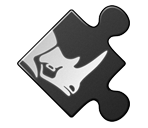Adding Mesh Objects
Windows only
Overview
To create an ON_Mesh:
- Create the
ON_Meshobject. The constructor requires the number of faces and vertices, and whether or not you have vertex normals or texture coordinates. - Fill in the mesh vertex array,
ON_Mesh::m_V. You can also useON_Mesh::SetVertex. - Fill in the mesh faces array,
ON_Mesh::m_F. You can also useON_Mesh::SetTriangleandON_Mesh::SetQuad. - If you have vertex normals, fill in the normals array,
ON_Mesh::m_N. You can also useON_Mesh::SetVertexNormal. - If you have texture coordinates, fill in the texture coordinate array,
ON_Mesh::m_T. You can also useON_Mesh::SetTextureCoordinate. - If you did not specify vertex normals, have Rhino compute them for you using
ON_Mesh::ComputeVertexNormals(). - Clean up everything using
ON_Mesh::Compact.
You are now ready to add this mesh object to the document. The opennurbs_mesh.h header file is well documented. It’s worth reading through at least once.
Example
CRhinoCommand::result CCommandTest::RunCommand( const CRhinoCommandContext& context )
{
// Example demonstrates how to create a mesh and add it to Rhino
// Create a mesh to write.
// The mesh is a pyramid with 4 triangular sides and a quadranglar
// base. The mesh has 5 vertices and 5 faces.
// The side faces share normals at their common vertices. The
// quadrangular base has normals different from the side normal.
// Coincident vertices that have distinct normals must be
// duplicated in the vertex list.
//
// The apex will be at (1,1.5,4) with normal (0,0,1).
// The base corners will be at (0,0,0), (0,2,0), (2,3,0), (0,3,0).
bool bHasVertexNormals = true; // we will specify vertex normals
bool bHasTexCoords = false; // we will not specify texture coordinates
const int vertex_count = 5+4; // 4 duplicates for different base normals
const int face_count = 5; // 4 triangle sides and a quad base
ON_Mesh mesh( face_count, vertex_count, bHasVertexNormals, bHasTexCoords );
// The SetVertex(), SetNormal(), SetTCoord() and SetFace() functions
// return true if successful and false if input is illegal. It is
// a good idea to inspect this returned value.
// vertex #0: apex location and normal
mesh.SetVertex( 0, ON_3dPoint(1.0, 1.5, 5.0) );
mesh.SetVertexNormal( 0, ON_3dVector(0.0, 0.0, 1.0) );
// vertex #1: SW corner vertex for sides
mesh.SetVertex( 1, ON_3dPoint(0.0, 0.0, 0.0) );
mesh.SetVertexNormal( 1, ON_3dVector(-1.0, -1.0, 0.0) ); // set normal will unitize if needed
// vertex #2: SE corner vertex for sides
mesh.SetVertex( 2, ON_3dPoint(2.0, 0.0, 0.0) );
mesh.SetVertexNormal( 2, ON_3dVector(+1.0, -1.0, 0.0) );
// vertex #3: NE corner vertex for sides
mesh.SetVertex( 3, ON_3dPoint(2.0, 3.0, 0.0) );
mesh.SetVertexNormal( 3, ON_3dVector(+1.0, +1.0, 0.0) );
// vertex #4: NW corner vertex for sides
mesh.SetVertex( 4, ON_3dPoint(0.0, 3.0, 0.0) );
mesh.SetVertexNormal( 4, ON_3dVector(-1.0, +1.0, 0.0) );
// vertex #5: SW corner vertex for base
mesh.SetVertex( 5, ON_3dPoint(0.0, 0.0, 0.0) ); // == location of v1
mesh.SetVertexNormal( 5, ON_3dVector(0.0, 0.0, -1.0) );
// vertex #6: SE corner vertex for base
mesh.SetVertex( 6, ON_3dPoint(2.0, 0.0, 0.0) ); // == location of v2
mesh.SetVertexNormal( 6, ON_3dVector(0.0, 0.0, -1.0) );
// vertex #7: SW corner vertex for base
mesh.SetVertex( 7, ON_3dPoint(2.0, 3.0, 0.0) ); // == location of v3
mesh.SetVertexNormal( 7, ON_3dVector(0.0, 0.0, -1.0) );
// vertex #8: SW corner vertex for base
mesh.SetVertex( 8, ON_3dPoint(0.0, 3.0, 0.0) ); // == location of v4
mesh.SetVertexNormal( 8, ON_3dVector(0.0, 0.0, -1.0) );
// Faces have vertices ordered counter-clockwise
// South side triangle
mesh.SetTriangle( 0, 1, 2, 0 );
// East side triangle
mesh.SetTriangle( 1, 2, 3, 0 );
// North side triangle
mesh.SetTriangle( 2, 3, 4, 0 );
// West side triangle
mesh.SetTriangle( 3, 4, 1, 0 );
// last face is quadrangular base
mesh.SetQuad( 4, 5, 8, 7, 6 );
//////////////////////////////////////////////////////////////
//////////////////////////////////////////////////////////////
if( mesh.IsValid() )
{
// Most applications expect vertex normals.
// If they are not present, ComputeVertexNormals sets
// them by averaging face normals.
if ( !mesh.HasVertexNormals() )
mesh.ComputeVertexNormals();
context.m_doc.AddMeshObject( mesh );
context.m_doc.Redraw();
}
return success;
}
Here is another example:
CRhinoCommand::result CCommandTest::RunCommand(const CRhinoCommandContext& context)
{
int face_count = 6;
int vertex_count = 12;
BOOL bVertexNormals = FALSE;
BOOL bTextureCoordinates = FALSE;
ON_Mesh mesh( face_count, vertex_count, bVertexNormals, bTextureCoordinates );
mesh.SetVertex( 0, ON_3fPoint(0.0f, 0.0f, 1.0f) );
mesh.SetVertex( 1, ON_3fPoint(1.0f, 0.0f, 1.0f) );
mesh.SetVertex( 2, ON_3fPoint(2.0f, 0.0f, 1.0f) );
mesh.SetVertex( 3, ON_3fPoint(3.0f, 0.0f, 0.0f) );
mesh.SetVertex( 4, ON_3fPoint(0.0f, 1.0f, 1.0f) );
mesh.SetVertex( 5, ON_3fPoint(1.0f, 1.0f, 2.0f) );
mesh.SetVertex( 6, ON_3fPoint(2.0f, 1.0f, 1.0f) );
mesh.SetVertex( 7, ON_3fPoint(3.0f, 1.0f, 0.0f) );
mesh.SetVertex( 8, ON_3fPoint(0.0f, 2.0f, 1.0f) );
mesh.SetVertex( 9, ON_3fPoint(1.0f, 2.0f, 1.0f) );
mesh.SetVertex( 10, ON_3fPoint(2.0f, 2.0f, 1.0f) );
mesh.SetVertex( 11, ON_3fPoint(3.0f, 2.0f, 1.0f) );
mesh.SetQuad( 0, 0, 1, 5, 4 );
mesh.SetQuad( 1, 1, 2, 6, 5 );
mesh.SetQuad( 2, 2, 3, 7, 6 );
mesh.SetQuad( 3, 4, 5, 9, 8 );
mesh.SetQuad( 4, 5, 6, 10, 9 );
mesh.SetQuad( 5, 6, 7, 11, 10 );
mesh.ComputeVertexNormals();
mesh.Compact();
context.m_doc.AddMeshObject( mesh );
context.m_doc.Redraw();
return CRhinoCommand::success;
}

